Ever stumbled upon a peculiar-looking fish while strolling along the shoreline, or maybe savored one on your dinner plate? Meet the flatfish—an extraordinary creature with unique adaptations to help it thrive in underwater homes.
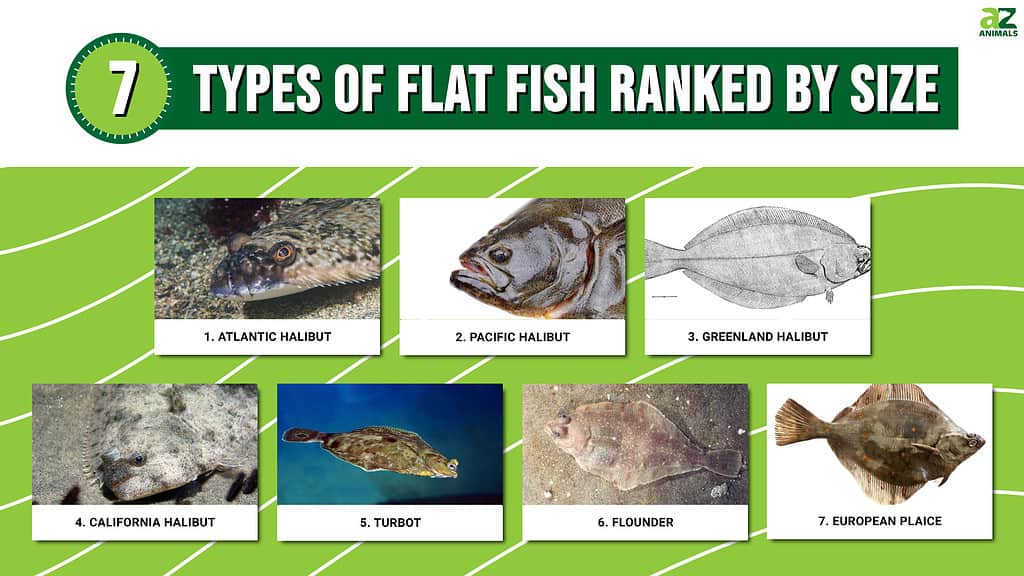
In this article, we’ll explore the fascinating world of these remarkable fish, ranking the seven largest flatfish species by size. So, come along on an underwater adventure as we dive into their habitats, distribution, and culinary importance.
Buckle up, and let’s dive into this aquatic wonderland together!
#1: Atlantic Halibut (Hippoglossus hippoglossus) – 15 feet, 700 Pounds
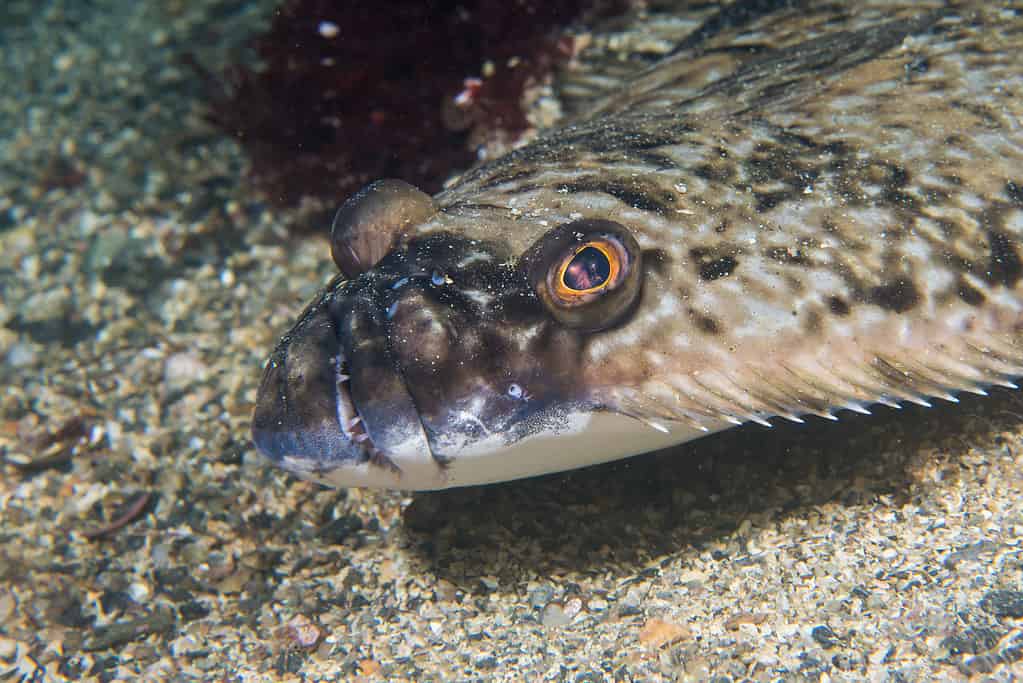
The Atlantic halibut truly lives up to its reputation as a behemoth, with some individuals reaching 15 feet!
©Joern_k/Shutterstock.com
Hold onto your snorkels because we’re kicking off our list with a real giant—the Atlantic halibut!
This impressive flatfish reigns as the undisputed heavyweight champion of the flatfish world. It has a few jaw-dropping traits that make it stand out from the rest.
Size and Weight
The Atlantic halibut truly lives up to its reputation as a behemoth. Some individuals reach an astonishing length of up to 15 feet and a weight of over 700 pounds!
The Atlantic halibut is not only the largest flatfish but also one of the largest bony fish in the world.
Habitat and Distribution
The Atlantic halibut prefers the chilly depths of the North Atlantic Ocean. It cruises along the ocean floor at depths of 160-6,560 feet.
You can find them from the coast of Greenland all the way to the Barents Sea, as well as along the eastern seaboard of North America, from Labrador down to New England.
Economic and Culinary Importance
The Atlantic halibut’s massive size and firm, lean, white flesh make it a highly sought-after species in commercial fishing. It is a favorite among seafood lovers.
Chefs around the world showcase this delicious fish in a variety of mouthwatering dishes. These include pan-seared halibut with a buttery lemon sauce or a succulent halibut ceviche. One taste of this ocean titan, and you’ll be hooked!
#2: Pacific Halibut (Hippoglossus stenolepis) – 8.2 feet, 500 Pounds
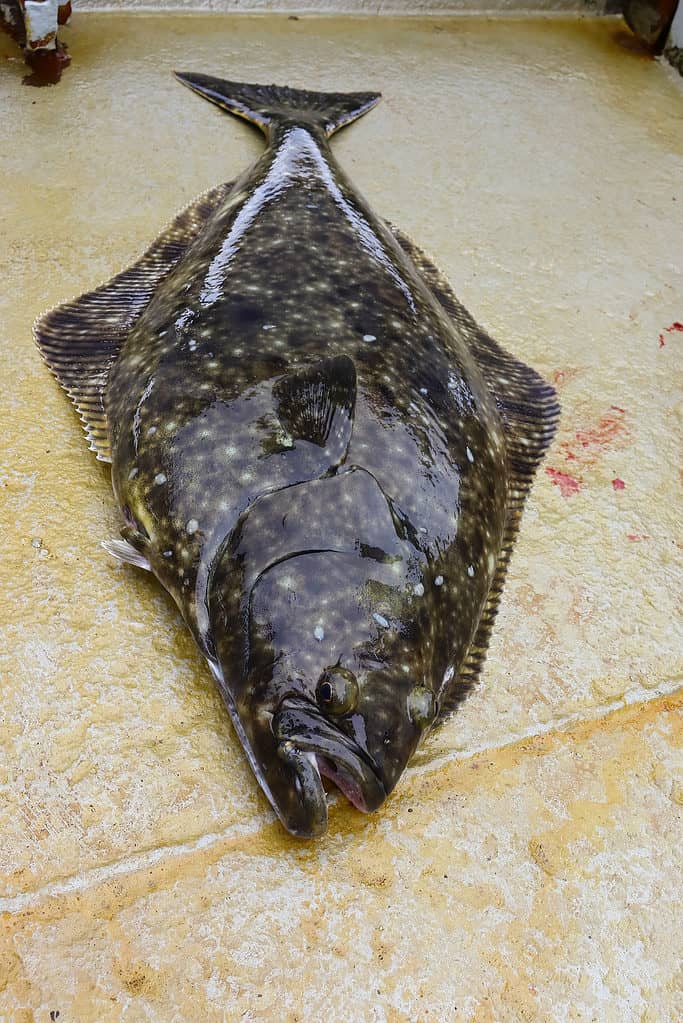
These flatfish giants are not only impressive in size but also known for their incredible strength and fighting spirit.
©Nick Kashenko/Shutterstock.com
Get ready to journey to the other side of the world as we check out the Pacific halibut. This fish is the Atlantic halibut’s close cousin and another true titan of the flatfish world.
This west coast wonder shares many similarities with its Eastern counterpart but has a few unique quirks that set it apart.
Size and Weight
The Pacific halibut doesn’t quite reach the colossal size of the Atlantic halibut. However, it still packs a punch in the size department.
With a maximum recorded length of around 8.2 feet and a weight of over 500 pounds, the Pacific halibut is undoubtedly a force to be reckoned with.
These flatfish giants are not only impressive in size but also known for their incredible strength and fighting spirit. Due to this, they are a popular target for sport fishing enthusiasts.
Habitat and Distribution
The Pacific halibut prefers the North Pacific Ocean’s cold, deep waters, ranging from the Aleutian Islands and Bering Sea all the way down to Southern California.
They inhabit depths of 20-3,600 feet, typically residing on the ocean floor near the continental shelf. Here, they blend in with the sandy or muddy seabed.
Economic and Culinary Importance
The Pacific halibut is a staple in commercial fishing and a prized catch for its tender, mildly sweet flavor. Its firm, white flesh is versatile and can be prepared in various ways. These include grilling and baking to frying and broiling.
The Pacific halibut’s delectable taste and high-quality meat have earned it a spot on many restaurant menus. It often stars in dishes like grilled halibut with mango salsa or a rich halibut chowder.
One bite of this west coast wonder, and you’ll see why it’s a favorite among seafood lovers!
#3: Greenland Halibut (Reinhardtius hippoglossoides) – 4.6 Feet, 100 Pounds
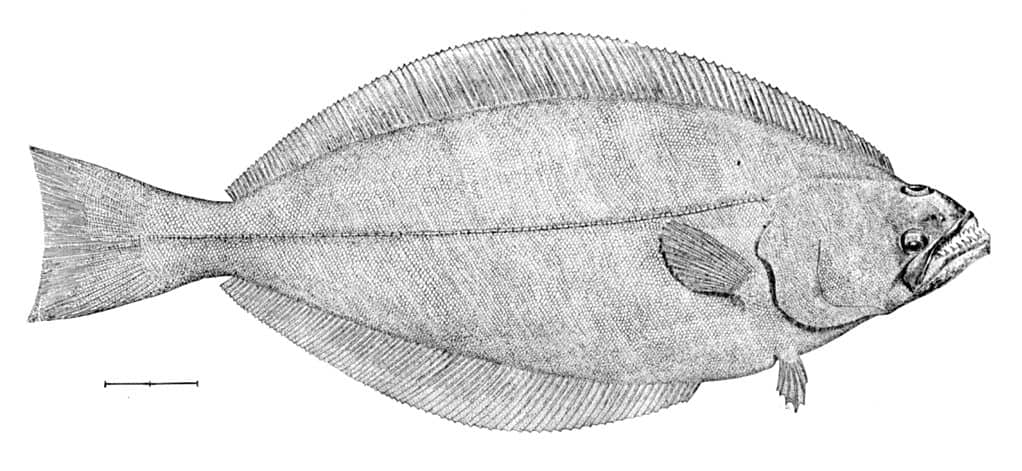
Though the Greenland halibut doesn’t match the enormous size of the Atlantic or Pacific halibut, it’s still an impressive flatfish in its own right.
©public domain – License
Bundle up because we’re venturing into the icy waters of the Arctic to meet the mysterious Greenland halibut. This flatfish thrives in some of the coldest depths of the ocean.
This intriguing species, also known as the “black halibut,” has a few unique features that make it stand out.
Size and Weight
Though the Greenland halibut doesn’t quite match the enormous size of the Atlantic or Pacific halibut, it’s still an impressive flatfish in its own right.
These cold-water dwellers can grow up to 4.6 feet long and weigh over 100 pounds. These stats make them among the largest flatfish species in the Arctic.
Don’t let their size fool you, though. They’re masters of stealth, blending seamlessly into the ocean floor as they lie in wait for their prey.
Habitat and Distribution
The Greenland halibut thrives in the frigid waters of the Arctic and North Atlantic Oceans. It inhabits depths ranging from 660 to 4,900 feet.
You can find these icy adventurers from the coasts of Greenland and Iceland all the way to the Barents Sea and the waters off of Northern Canada and Alaska.
One fascinating adaptation to their cold-water habitat is their slow metabolism. This allows them to survive on less food and in colder temperatures than their warm-water cousins.
Economic and Culinary Importance
The Greenland halibut is a valuable species in commercial fishing, particularly in the Arctic regions where it’s caught.
Its firm, white flesh has a mild flavor and a slightly higher fat content than other halibut. This gives it a rich, buttery texture.
This versatile fish can be prepared in a variety of ways, from pan-frying to baking. It’s a popular ingredient in traditional Arctic dishes. Give Greenland halibut a try, and you might just find a new favorite for your seafood repertoire!
#4: California Halibut (Paralichthys californicus) – 5 Feet, 72 Pounds
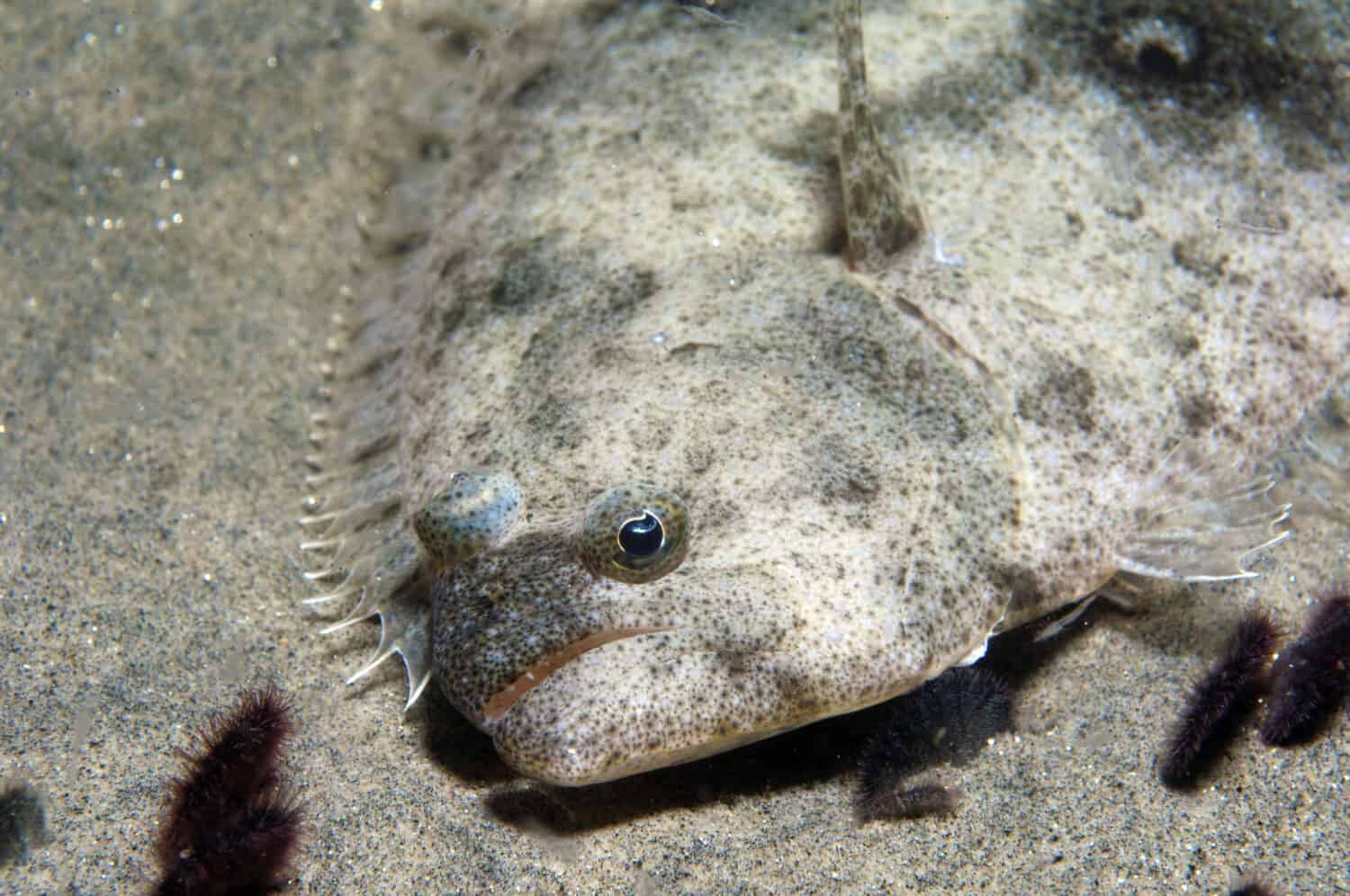
California Halibut is a popular fish served in West Coast restaurants.
©Greg Amptman/Shutterstock.com
Welcome to the sun-soaked shores of the Golden State, where the California halibut basks in the warmer waters of the Pacific Ocean.
This West Coast gem is a beloved local icon. While it might not match the colossal size of some of its relatives, it still holds its own in terms of flavor and versatility.
Size and Weight
While the California halibut might not be the biggest fish in the sea, it’s still an impressive flatfish. Adults typically reach lengths of up to 5 feet and weigh in at around 72 pounds.
Don’t underestimate these sun-loving swimmers. They’re agile and powerful predators, skillfully stalking their prey along the ocean floor.
Habitat and Distribution
The California halibut enjoys the warmer coastal waters of the Eastern Pacific. They range from the Quillayute River in Washington to the tip of Baja California in Mexico.
These flatfish prefer sandy or muddy bottoms and live at depths of 10-360 feet. The California halibut is especially fond of the shallow waters near the shore. It is an accessible and popular target for both commercial and recreational anglers.
Economic and Culinary Importance
The California halibut is a staple in commercial and sport fishing along the Pacific coast. Its tender, flaky, white flesh has made it a favorite among seafood enthusiasts.
It’s mild flavor and versatile texture make it an excellent canvas for a variety of culinary creations. These include grilled halibut tacos with a zesty cilantro-lime sauce to a delicate halibut ceviche with avocado and tomatoes.
Next time you’re in California, be sure to treat yourself to this local delight—your taste buds will thank you!
#5: Turbot (Scophthalmus maximus) 3.3 Feet, 55 Pounds

Its unique diamond-shaped body and large, bony head give it a distinguished appearance that sets it apart from other flatfish.
©slowmotiongli/Shutterstock.com
Fasten your seatbelts as we journey to the European coastline to discover the regal turbot. This flatfish has been treasured by gourmets for centuries.
With its distinctive diamond-shaped body and delicate flavor, the turbot has earned a place in the world of fine dining.
Size and Weight
The turbot is an impressive flatfish that can grow up to 3.3 feet in length and weigh over 55 pounds.
Its unique diamond-shaped body and large, bony head give it a distinguished appearance that sets it apart from other flatfish. It certainly holds its own in terms of prestige and culinary appeal.
Habitat and Distribution
Turbot inhabits the coastal waters of the northeast Atlantic, from Iceland and Norway down to the Mediterranean Sea and the Black Sea.
These elegant flatfish prefer sandy or muddy bottoms and live at depths of 33-230 feet. Their preference for the cooler waters of the European coastline has made them a staple in the region’s fishing industry and a sought-after catch for anglers.
Economic and Culinary Importance
The turbot’s firm, white flesh, and subtle, refined flavor have long made it a favorite among chefs and gourmets alike.
It is called the “king of flatfish.” The turbot has graced the tables of European royalty and has been the star of countless high-end dishes.
From a classic French turbot meunière with brown butter and capers to a luxurious turbot fillet poached in champagne, this flatfish is the epitome of culinary excellence.
Don’t miss the opportunity to indulge in the exquisite taste of turbot. It’s a dining experience you won’t soon forget!
#6: Flounder (Paralichthys spp.) – 3 feet, 22 Pounds

The
flounder
family is incredibly diverse, with numerous species found in oceans worldwide.
©Michele Ursi/Shutterstock.com
Get ready to meet one of the most iconic and recognizable flatfish—the flounder!
With its distinctive appearance and a wide array of species, the flounder has captured the hearts of people around the world.
Size and Weight
The flounder family is incredibly diverse, with numerous species found in oceans worldwide.
The size of flounders can vary greatly depending on the species. However, they generally fall within a range of 10 inches to 3 feet and can weigh up to 22 pounds.
These flatfish may not be the largest in the sea, but they certainly know how to make a big impression. They have a unique appearance and incredible camouflage abilities.
Habitat and Distribution
Flounders reside in a wide range of ocean environments, from shallow coastal waters to deep-sea depths.
These adaptable fish inhabit sandy or muddy bottoms. They blend seamlessly with their surroundings to evade predators and ambush prey.
Flounders live in oceans across the globe, from the chilly waters of the North Atlantic to the warmer seas of the Indian Ocean. They are one of the most widely distributed flatfish families.
Economic and Culinary Importance
Flounders are a popular target for both commercial and recreational fishing. Their tender, mild-flavored flesh is highly prized in the culinary world.
The versatility of flounder makes it a favorite choice for a variety of dishes. Try a simple pan-fried fillet with a squeeze of lemon or more elaborate creations like flounder stuffed with crabmeat and topped with a creamy beurre blanc sauce.
No matter how you prepare it, flounder is sure to be a hit with seafood lovers everywhere. So go ahead, give Flounder a try, and discover the magic of these enchanting flatfish for yourself!
#7: European Plaice (Pleuronectes platessa) 3.3 Feet, 14 Pounds
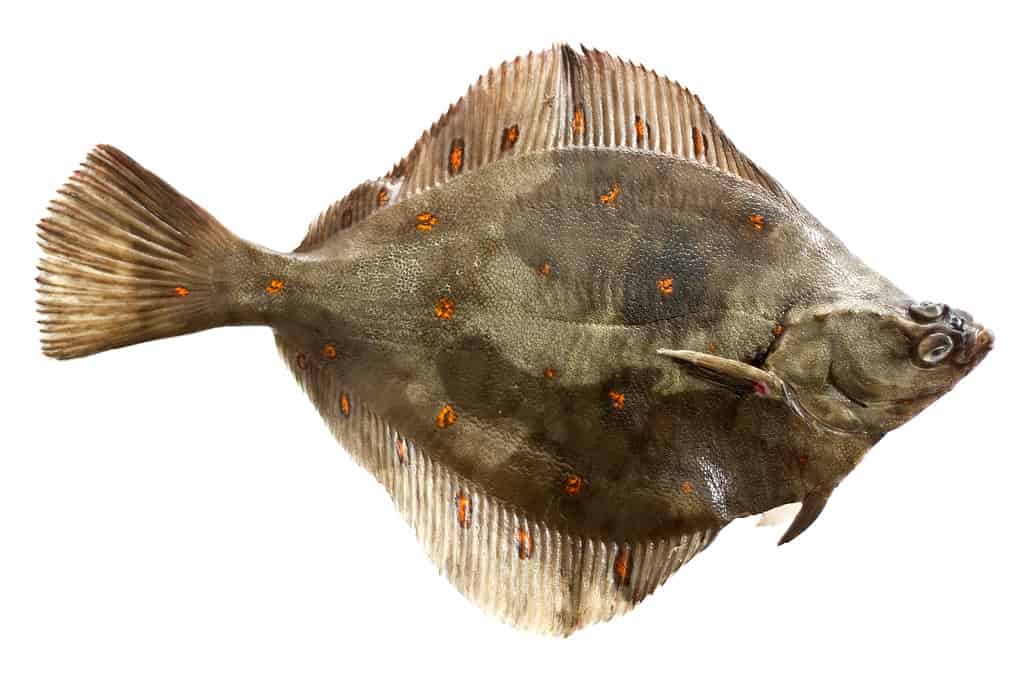
These adaptable flatfish live at depths of 33-650 feet, usually inhabiting sandy or muddy bottoms near the shore.
© kavring/Shutterstock.com
Meet the charming European plaice, a flatfish that’s as delightful to look at as it is to eat.
With its distinctive red spots and playful personality, the European plaice has endeared itself to seafood lovers across the continent.
Size and Weight
The European plaice is a moderately sized flatfish. Adults typically reach lengths of up to 3.3 feet and weigh up to 14 pounds.
One of the most recognizable features of this species is its array of bright red or orange spots. These dots are scattered across its dark green or brown upper side. These eye-catching spots add a touch of whimsy to their appearance and help them blend with their surroundings.
Habitat and Distribution
The European plaice favors the cool coastal waters of the Northeast Atlantic, from the Barents Sea in the Arctic Circle down to the Mediterranean Sea.
These adaptable flatfish live at depths of 33-650 feet, usually inhabiting sandy or muddy bottoms near the shore.
Their wide distribution and preference for shallow waters have made them a popular target for both commercial and recreational fishermen.
Economic and Culinary importance
European plaice is a staple in the commercial fishing industry. It is also a favorite among seafood enthusiasts for its delicate, sweet flavor and fine, flaky texture.
This versatile fish can be used for classic British fish and chips. It can also be part of more refined dishes, like a pan-seared plaice fillet with a tangy citrus sauce.
No matter how it’s served, European plaice is a delicious and delightful addition to any seafood lover’s plate. So go ahead, indulge in a taste of Europe’s finest, and discover the joy of European plaice for yourself!
Key Takeaways
And there you have it—our deep dive into the seven largest flatfish species in the world!
We’ve explored the mighty Atlantic halibut to the delicately flavored European plaice. These extraordinary fish have captivated us with their unique biology, diverse habitats, and mouthwatering culinary appeal. We hope this aquatic adventure has expanded your knowledge and deepened your appreciation for the wonders of the underwater world.
As you cast your line into the vast ocean of life, remember the fascinating flatfish and their remarkable adaptations. Who knows? Maybe you’ll find yourself inspired to explore more about these aquatic marvels or even try a new flatfish dish!
Summary of 7 Types of Flat Fish Ranked by Size
| Rank | Flat Fish | Weight |
|---|---|---|
| 1 | Atlantic Halibut | 700 pounds |
| 2 | Pacific Halibut | 500 pounds |
| 3 | Greenland Halibut | 100 pounds |
| 4 | California Halibut | 72 pounds |
| 5 | Turbot | 55 pounds |
| 6 | Flounder | 22 pounds |
| 7 | European Plaice | 14 pounds |
The photo featured at the top of this post is © iStock.com/Getty Images
Thank you for reading! Have some feedback for us? Contact the AZ Animals editorial team.






